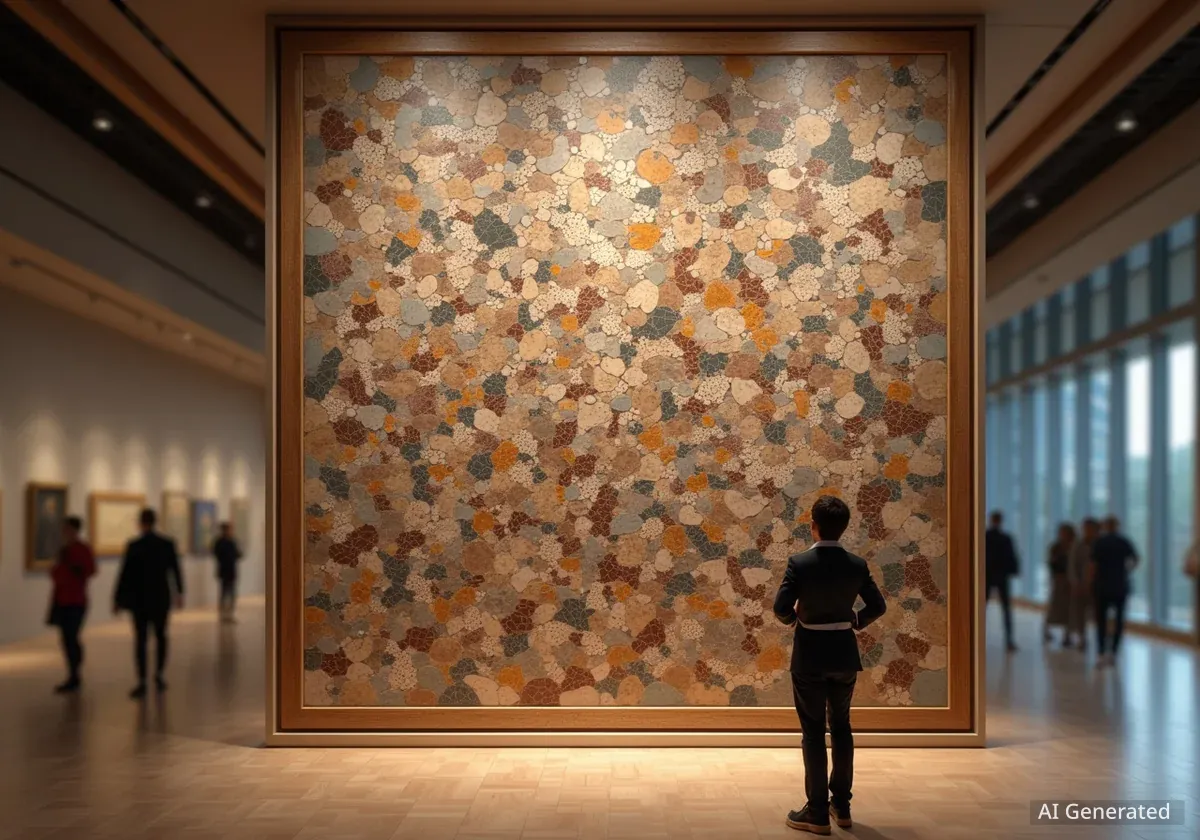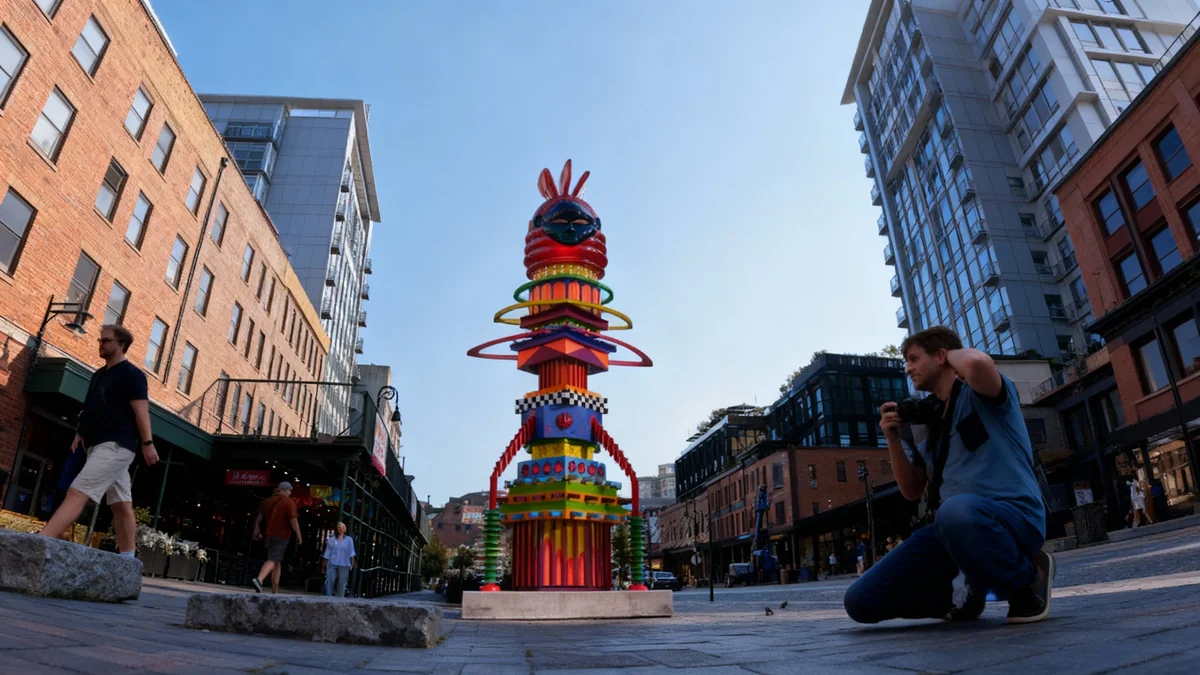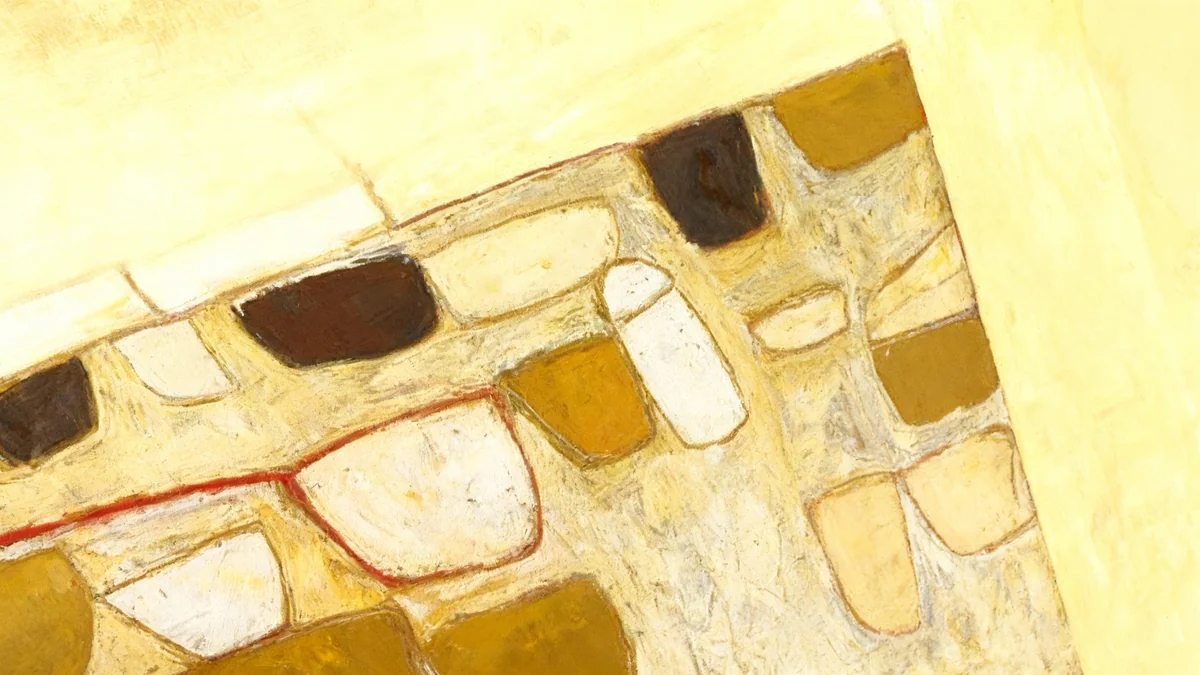Visitors to the Guggenheim Museum in New York are exploring a major solo exhibition by artist Rashid Johnson, titled A Poem for Deep Thinkers. The exhibition, running until January 18, 2026, features 90 works from Johnson's nearly 30-year career. A key piece, 'Three Broken Souls,' a half-ton mosaic, stands prominently at the museum's entrance, offering complex layers of meaning.
This mosaic, completed in 2025 specifically for the exhibition, measures 20 feet and weighs over 1,000 pounds. It serves as a focal point, drawing attention with its scale and intricate details. The work reflects Johnson's artistic evolution and his deep engagement with themes of Black identity and culture.
Key Takeaways
- Rashid Johnson's exhibition at the Guggenheim features 90 works.
- 'Three Broken Souls' is a 20-foot, half-ton mosaic at the museum entrance.
- The mosaic uses diverse materials like tiles, mirrors, and oyster shells.
- It explores themes of Black identity, fatherhood, and vulnerability.
- Curator Naomi Beckwith highlights hidden symbols and personal references within the art.
Exploring 'Three Broken Souls'
'Three Broken Souls' is a mosaic crafted from various materials. These include ceramic tiles, mirrors, oyster shells, and other objects. Johnson sourced or made these components, binding them with glue and grout. He then applied black soap and wax to the surface, adding further texture and symbolic depth.
According to Naomi Beckwith, Deputy Director of the Guggenheim and the exhibition's main curator, Johnson designed the mosaic to frame the museum's large entrance hall. It also provides a powerful backdrop for musical events, talks, and performances held during the exhibition period. Beckwith notes that this work continues a series of mosaics Johnson has created since 2015.
Artist's Perspective on Identity
Rashid Johnson has diversified his artistic practice over the years. He works across photography, painting, video, audio, performance, mosaic, and sculpture. Much of his art delves into Black identity and culture. He rejects labels like 'conceptual post-Black art,' preferring visitors to engage with his work directly.
"For my generation, having grown up in the age of hip-hop and Black Entertainment Television, there’s less of a need to define the Black experience so aggressively to a white audience. I think it gives us a different type of opportunity to have a more complex conversation around race and identity."
— Rashid Johnson
Johnson encourages visitors to approach his exhibition "with an open mind and an open heart . . . and ready to bear witness." He wants people to reflect on what they see, rather than just passively observe.
Materials and Their Meanings
The materials Johnson uses in 'Three Broken Souls' are not random. Each element carries specific significance, often drawing from his personal history and cultural references. Beckwith shared her interpretation of these symbols, based on her extensive knowledge of Johnson's work and their long-standing friendship.
Symbolic Figures and Spiritual Journeys
- Three Figures: The mosaic features three boat-like shapes. These shapes may represent women, spirits, or double figures. They refer to themes of escape and rituals of the afterlife, suggesting Johnson's spiritual side.
- Spiritual Home: Johnson has spoken about finding a spiritual center in his art. He describes his studio as playing the role of a spiritual home, given his parents' differing religious backgrounds.
Tiles: Memory and Fragmentation
Ceramic tiles form a large part of the mosaic. These tiles evoke Johnson's memories of a Chicago Russian bathhouse he frequented in his twenties. There, he listened to civic leaders. While he often uses whole tiles, in 'Three Broken Souls' and other recent mosaics, the tiles are fragmented. This fragmentation can suggest broken trust.
Over the past decade, Johnson has moved from black and white tiles to a broader color palette. His techniques are inspired by Antoni Gaudí, the Catalan architect known for the Sagrada Familia church. Johnson encountered Gaudí's work during his travels in Barcelona.
Shea Butter's Cultural Significance
The color yellow in the mosaic reflects shea butter. This material is a uniquely African ingredient, extracted from the karite tree fruit. Black communities worldwide have used shea butter for centuries in hair and skincare. Johnson states that "Shea butter speaks to body coating and the failure to acquire an African-ness through its application." This highlights a complex relationship with cultural identity and assimilation.
Reflections and Viewer Engagement
Johnson often includes broken mirrors in his work. In 'Three Broken Souls,' the glass elements serve a similar purpose. Viewers looking at the artwork also see themselves reflected as part of the art. This technique encourages self-reflection and personal engagement with the piece.
"I’m adopting materials, giving them a home, and employing them in my lexicon. My use of materials relies heavily on my personal relationship to them. Every material I use has a utilitarian purpose."
— Rashid Johnson
Wax and Ancient Art Forms
Black hot wax is another significant material. Unlike the industrial adhesives used for embedding objects, the wax allows Johnson to work directly with his hands, creating twisting shapes. This wax nods to several historical art forms:
- Byzantine Empire: Encaustic wax painting.
- 1970s Pan-Africanism Movement: Batik art.
The wax is applied to bronze, a material traditionally associated with high art. This combination creates a dialogue between ancient techniques and contemporary cultural movements.
Hidden Symbols and Personal Narratives
The mosaic includes an almond shape, which represents the intersection of two circles. This shape is a Byzantine symbol of the divine. It also references warrior shields from the 1980s South African TV series Shaka Zulu, which Johnson watched growing up. Interestingly, Chaka is also the name of his brother, a subtle inclusion of family in his work.
Oyster shells in the mosaic refer to Zora Neale Hurston’s 1928 essay, "How It Feels to Be Colored Me." This reference hints at potential violence and resilience, as Hurston writes: "I am not tragically colored. Even in the helter-skelter skirmish that is my life, I have seen that the world is to the strong regardless of a little pigmentation more or less. No, I do not weep at the world — I am too busy sharpening my oyster knife."
Earlier Mosaics and Themes
Since 2015, Johnson has created several mosaics exploring fatherhood, vulnerability, and the Black American experience. These include 'Anxious Men,' 'The Broken Nine,' 'Untitled (Broken Crowd),' and 'The Broken Five.' The latter may refer to the Central Park Five, who were wrongfully convicted and later pardoned.
Johnson told the New York Times that his work addresses "race, struggle, grief and grievance, but also joy and excitement around the tradition and opportunities of Blackness." He aims to illustrate diverse individuals, all of whom, in a sense, represent aspects of himself.
The Broader Exhibition
While 'Three Broken Souls' captures immediate attention, it is part of a larger exhibition. Another prominent work, 'Sanguine,' is a suspended garden of living plants. Full palm trees, monsteras, and cacti hang from the Guggenheim's rafters, creating a striking visual experience within the main rotunda.
The exhibition, A Poem for Deep Thinkers, showcases Johnson's extensive career. It invites viewers to engage with art that is both visually stunning and intellectually challenging. The diverse range of media and themes demonstrates Johnson's continuous artistic growth and his commitment to exploring complex societal issues.
From a distance, 'Three Broken Souls' commands attention through its sheer size and varied textures. Up close, it reveals the intricate layers of Johnson's influences, personal narratives, and artistic development. The exhibition provides a comprehensive look at an artist who uses his platform to foster deeper conversations about identity and human experience.




